As of December 31, 2025, the Nifty 50 returns are:
- 1Y Return of NIFTY 50: 10.51%, reflecting strong short-term momentum.
- 3Y CAGR of NIFTY 50: 13.01%, indicating robust recovery and growth.
- 5Y CAGR of NIFTY 50: 13.32%, demonstrating solid medium-term performance.
- 10Y CAGR of NIFTY 50: 12.64%, driven by effective long-term compounding.
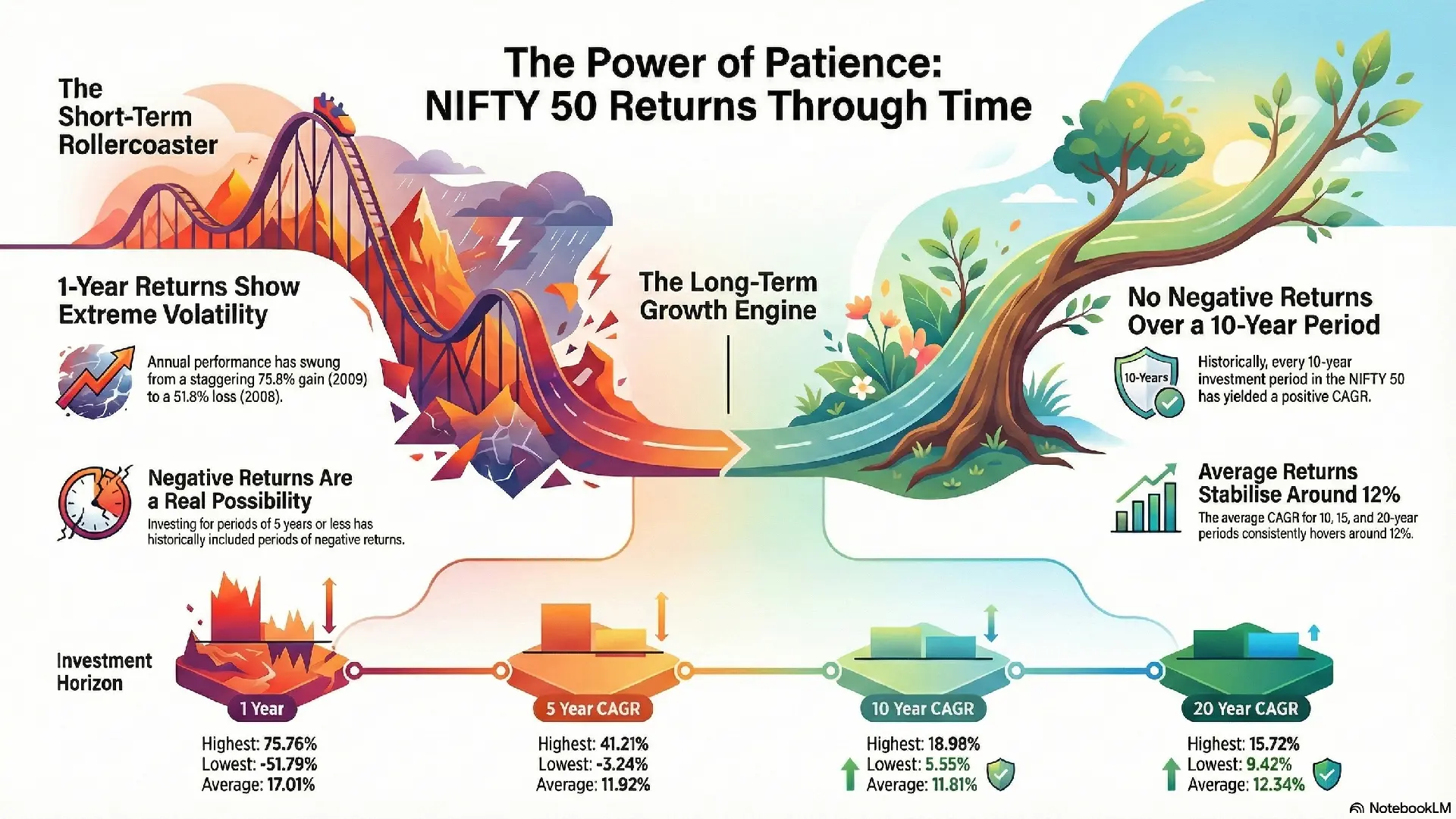
1.0 Introduction
This analysis dissects the historical performance of India's benchmark NIFTY 50 index across a spectrum of investment durations, ranging from one year to thirty years. The core objective is to evaluate the critical relationship between an investor's time horizon, the volatility of returns, and the probability of achieving positive outcomes. By examining historical data, this report aims to provide actionable insights for investors and financial analysts seeking to understand the risk and reward profile of the Indian equity market. All data presented is based on historical performance, with returns and Compound Annual Growth Rates (CAGRs) calculated as of December 31st for each respective year. We begin by exploring the market's behavior over the shortest, and most volatile, timeframes.
As of December 31, 2025, the Nifty 50 returns are:
- 1Y Return of NIFTY 50: 10.51%, reflecting strong short-term momentum.
- 3Y CAGR of NIFTY 50: 13.01%, indicating robust recovery and growth.
- 5Y CAGR of NIFTY 50: 13.32%, demonstrating solid medium-term performance.
- 7Y CAGR of NIFTY 50: 13.36%, supported by consistent market resilience.
- 10Y CAGR of NIFTY 50: 12.64%, driven by effective long-term compounding.
- 15Y CAGR of NIFTY 50: 10.14%, maintaining stability through multiple market cycles.
- 20Y CAGR of NIFTY 50: 11.74%, highlighting reliable wealth creation over decades.
- 25Y CAGR of NIFTY 50: 12.88%, showcasing impressive historical consistency.
- 30Y CAGR of NIFTY 50: 11.85%, evidencing the enduring strength of Indian equities.
- 35Y CAGR of NIFTY 50: 13.3%, underscoring remarkable sustained wealth creation over more than three decades.
| Date | 1Y Return | 3Y | 5Y | 7Y | 10Y | 15Y | 20Y | 25Y | 30Y | 35Y |
| 2025-12-31 | 10.51 | 13.01 | 13.32 | 13.36 | 12.64 | 10.14 | 11.74 | 12.88 | 11.85 | 13.3 |
| 2024-12-31 | 8.8 | 10.86 | 14.21 | 12.25 | 11.06 | 10.62 | 12.92 | 11.72 | 10.5 | |
| 2023-12-29 | 20.03 | 15.84 | 14.88 | 14.97 | 13.17 | 14.22 | 13.02 | 13.66 | 10.65 | |
| 2022-12-30 | 4.33 | 14.16 | 11.45 | 12.48 | 11.86 | 7.48 | 15.07 | 11.94 | 11.14 | |
| 2021-12-31 | 24.12 | 16.9 | 16.22 | 11.14 | 14.14 | 10.34 | 15.01 | 12.57 | 12.14 | |
| 2020-12-31 | 14.9 | 9.91 | 11.96 | 12.05 | 8.59 | 11.22 | 12.77 | 11.55 | 13.29 | |
| 2019-12-31 | 12.02 | 14.13 | 8 | 10.88 | 8.87 | 12.5 | 11.11 | 9.77 | ||
| 2018-12-31 | 3.15 | 10.98 | 11.5 | 12.98 | 13.89 | 12.41 | 13.36 | 9.83 | ||
| 2017-12-29 | 28.65 | 8.33 | 12.27 | 8.03 | 5.55 | 16.3 | 12.06 | 11.08 | ||
| 2016-12-30 | 3.01 | 9.1 | 12.1 | 6.69 | 7.51 | 14.61 | 11.68 | 11.34 | ||
| 2015-12-31 | -4.06 | 10.4 | 5.31 | 15.16 | 10.85 | 13.04 | 11.45 | 13.56 | ||
| 2014-12-31 | 31.39 | 21.44 | 9.75 | 4.37 | 14.82 | 12.16 | 10.22 | |||
| 2013-12-31 | 6.76 | 0.91 | 16.33 | 6.84 | 12.86 | 13.99 | 9.42 | |||
| 2012-12-31 | 27.7 | 4.32 | -0.77 | 11.04 | 18.37 | 12 | 10.79 | |||
| 2011-12-30 | -24.62 | 16.04 | 3.12 | 12.09 | 15.88 | 11.54 | 11.15 | |||
| 2010-12-31 | 17.95 | -0.02 | 16.68 | 18.41 | 17.12 | 13.58 | 15.72 | |||
| 2009-12-31 | 75.76 | 9.45 | 20.11 | 24.95 | 13.39 | 10.38 | ||||
| 2008-12-31 | -51.79 | 1.42 | 9.5 | 15.81 | 12.84 | 7.2 | ||||
| 2007-12-31 | 54.77 | 43.43 | 41.21 | 25.33 | 18.98 | 14.93 | ||||
| 2006-12-29 | 39.83 | 28.26 | 30.23 | 15.12 | 16 | 13.96 | ||||
| 2005-12-30 | 36.34 | 37.4 | 17.55 | 18.12 | 12.06 | 15.4 | ||||
| 2004-12-31 | 10.68 | 25.24 | 7.04 | 9.83 | 5.82 | |||||
| 2003-12-31 | 71.9 | 14.16 | 16.28 | 11.11 | 6.07 | |||||
| 2002-12-31 | 3.25 | -9.61 | 0.26 | 2.68 | 3.69 | |||||
| 2001-12-31 | -16.18 | 6.2 | 3.33 | -1.56 | 6.61 | |||||
| 2000-12-29 | -14.65 | 5.39 | 6.82 | 2.79 | 14.34 | |||||
| 1999-12-30 | 67.42 | 18.09 | 4.6 | 9.97 | ||||||
| 1998-12-31 | -18.08 | -0.9 | -3.24 | 6.78 | ||||||
| 1997-12-31 | 20.05 | -2.99 | 7.23 | 18.4 | ||||||
| 1996-12-31 | -1.04 | -4.81 | 9.99 | |||||||
| 1995-12-29 | -23.15 | 6.07 | 22.39 | |||||||
| 1994-12-23 | 13.4 | 28.39 | ||||||||
| 1993-12-24 | 36.94 | 46.6 | ||||||||
| 1992-12-24 | 36.28 | |||||||||
| 1991-12-24 | 68.84 | |||||||||
| 1990-12-24 | ||||||||||
| count | 35 | 33 | 31 | 29 | 26 | 21 | 16 | 11 | 6 | 1 |
| mean | 17.01 | 12.97 | 11.92 | 11.8 | 11.81 | 12.29 | 12.34 | 11.81 | 11.6 | 13.3 |
| std | 28.97 | 13.03 | 8.9 | 6.08 | 4.14 | 2.4 | 1.79 | 1.31 | 1.05 | |
| min | -51.79 | -9.61 | -3.24 | -1.56 | 3.69 | 7.2 | 9.42 | 9.77 | 10.5 | 13.3 |
| max | 75.76 | 46.6 | 41.21 | 25.33 | 18.98 | 16.3 | 15.72 | 13.66 | 13.29 | 13.3 |
| median | 13.4 | 10.86 | 11.5 | 12.05 | 12.74 | 12.41 | 11.9 | 11.72 | 11.5 | 13.3 |
| Positive Return Year Count | 27 | 28 | 29 | 28 | 26 | 21 | 16 | 11 | 6 | 1 |
| Negative Return Year Count | 8 | 5 | 2 | 1 | 0 | 0 | 0 | 0 | 0 | 0 |
RECOMMENDED READS
Overview of the Data
The dataset provides returns for the Nifty 50 Index over multiple time horizons: 1-year returns and CAGR for 3, 5, 7, 10, 15, 20, 25, and 30 years, calculated annually from 1991 to 2025. The data includes statistical measures such as mean, standard deviation, minimum, maximum, and quartiles, offering a robust framework to evaluate the index's performance.
Key Observation About NIFTY 50 Long-Term Return Analysis (31-Dec-2025)
2.0 Short-Term Horizon Analysis: Volatility and Risk (1- & 3-Year Periods)
Understanding short-term market dynamics is strategically important for appreciating the inherent risks of equity investing. These brief periods are highly susceptible to the influence of prevailing market sentiment, geopolitical events, and macroeconomic shocks, which collectively contribute to significant variability in returns. As this analysis shows, shorter holding periods expose investors to the widest possible range of outcomes, including substantial losses.
2.1 One-Year Returns: A Portrait of Extreme Volatility
The NIFTY 50's one-year returns offer a clear picture of market unpredictability. The historical data reveals an extreme range of outcomes, from a single-year high of 75.76% during the post-crisis recovery in 2009 to a staggering low of -51.79% during the 2008 Global Financial Crisis. Negative returns are a frequent occurrence in this timeframe; over the 35-year period shown, the NIFTY 50 ended with an annual loss in eight separate years: 1994, 1995, 1998, 2000, 2001, 2008, 2011, and 2015. This means investors faced a roughly 23% chance of capital loss over any given one-year period. The key insight is unambiguous: one-year holding periods are speculative in nature and expose investors to a significant and unpredictable risk of capital loss.
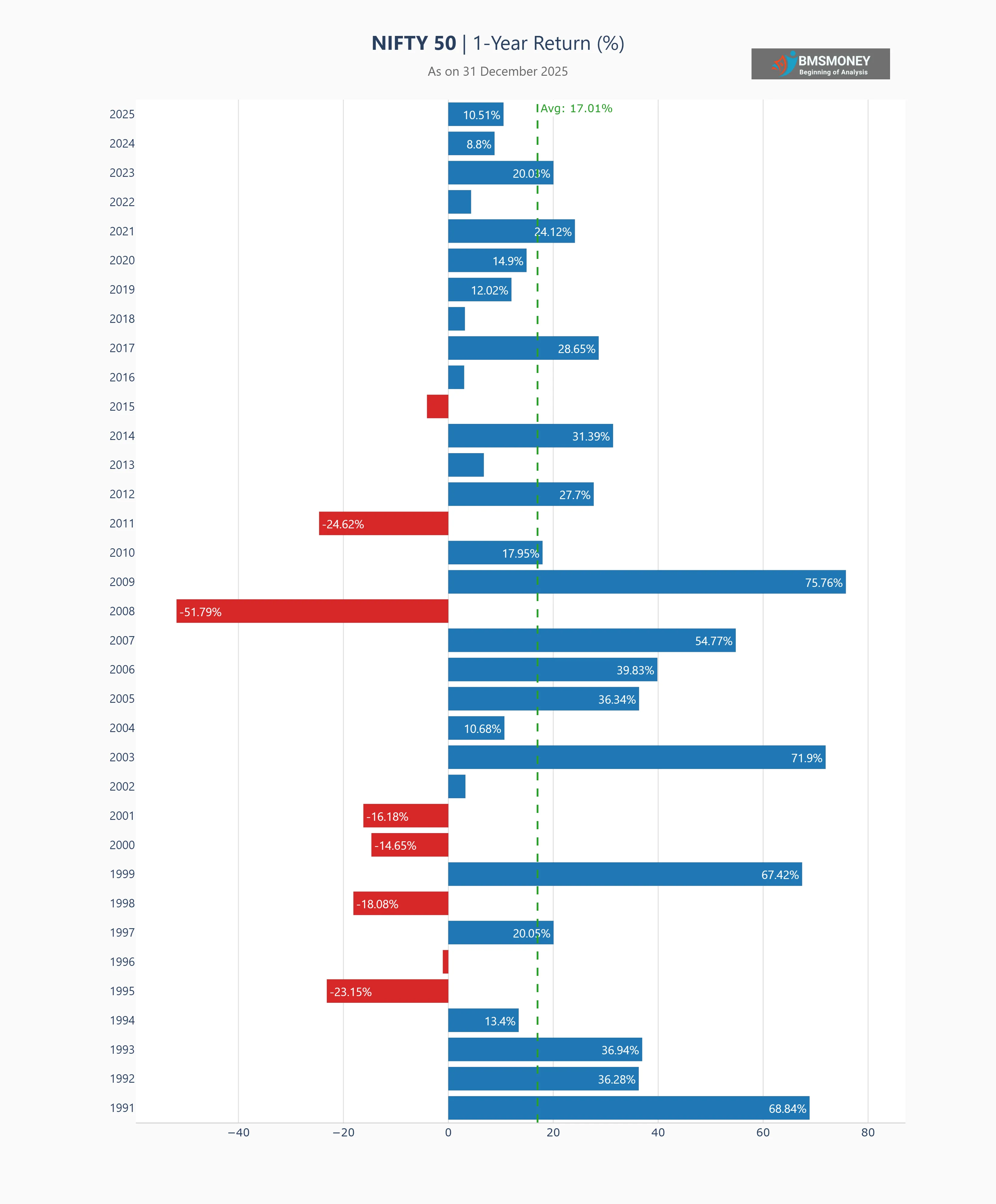
2.2 Three-Year CAGR: The First Signs of Moderation
Extending the investment horizon to a three-year rolling period begins to temper the extreme volatility observed in single-year returns. The range of annualized outcomes narrows considerably, with the maximum 3-year CAGR recorded at 46.6% (for the period ending in 1993) and the minimum at -9.61% (for the period ending in 2002). This represents a quantifiable reduction in return dispersion: the nearly 128 percentage-point range seen in one-year returns contracts to a much tighter 56 percentage-point range for three-year CAGRs. However, the risk of negative annualized returns remains present, as seen in the data for periods ending in 1996, 1997, and 2002. While a three-year horizon clearly begins to moderate risk, it fails to provide true capital security, underscoring the need to analyze the more stable outcomes found in medium-term periods.
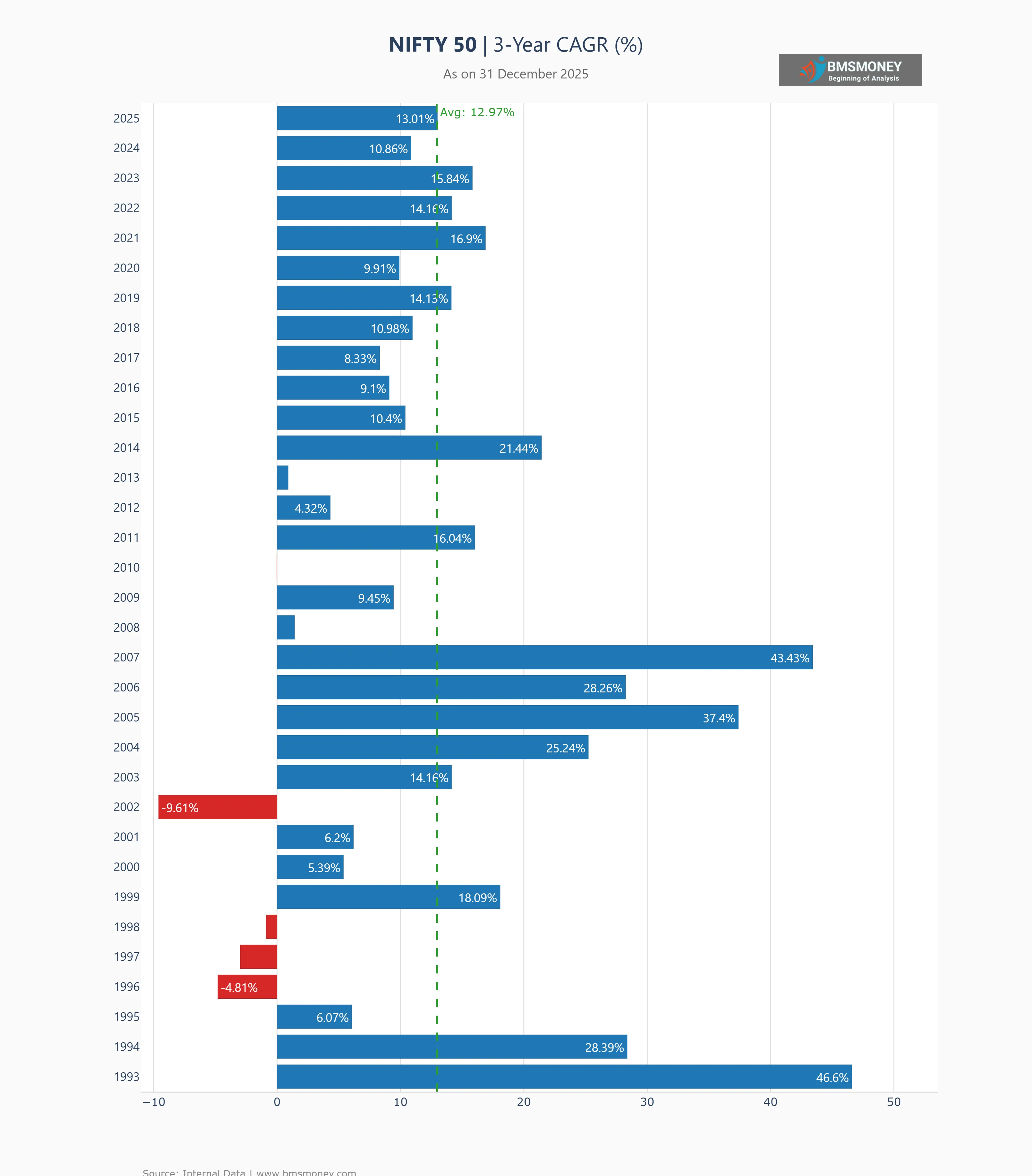
3.0 Medium-Term Horizon Analysis: The Emergence of Consistency (5- to 10-Year Periods)
Moving from a short-term to a medium-term investment horizon is a critical step where the effects of market volatility begin to meaningfully diminish. Over five to ten years, the underlying trend of economic growth starts to overshadow the noise of short-term market fluctuations, leading to more predictable and consistent investment outcomes.
3.1 Five- and Seven-Year CAGRs: A Significant Reduction in Downside Risk
The five-year holding period marks a dramatic shift, with downside risk nearly vanishing. Across the historical data analyzed, there was only a single instance of a negative 5-year CAGR: a relatively mild -3.24% for the period ending in 1998. Conversely, the maximum 5-year CAGR reached an impressive 41.21% (ending in 2007), showing that substantial upside potential remained. This trend of increasing capital preservation continues into the seven-year period. While the possibility of a nominal loss still existed—evidenced by one sole instance of a negative CAGR for the period ending in 2001—the risk was exceptionally low. The lowest positive 7-year CAGR was 2.68% (ending in 2002), while the maximum was a strong 25.33% (ending in 2007), demonstrating a clear trend: as the holding period lengthens, the probability of preserving capital increases dramatically.
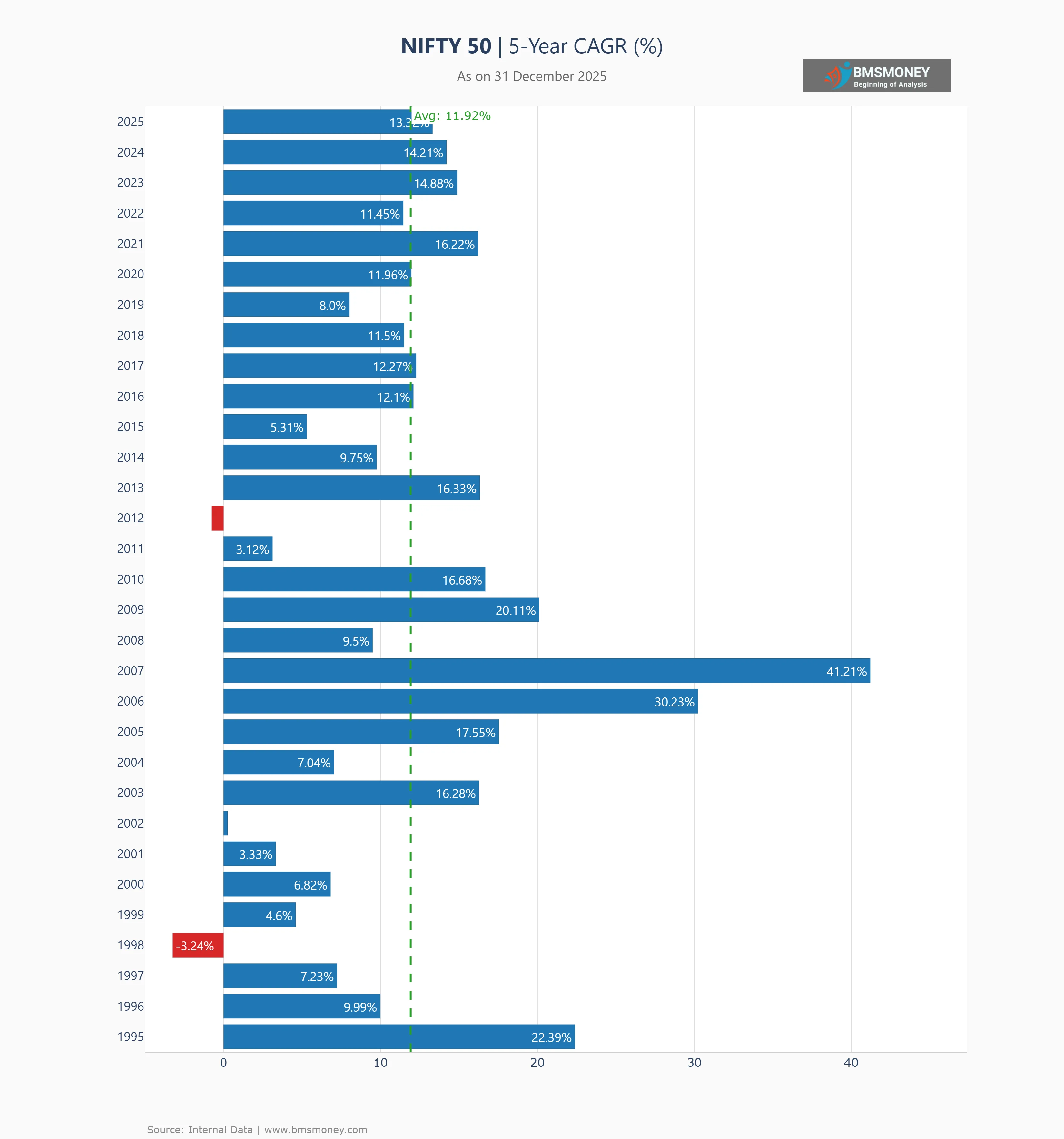
3.2 Ten-Year CAGR: A Critical Inflection Point
The ten-year investment horizon represents a pivotal milestone for long-term investors. The most important finding from this data set is that, based on the historical performance analyzed, no 10-year investment period in the NIFTY 50 resulted in a negative Compound Annual Growth Rate. A ten-year horizon has historically proven sufficient to absorb the shock of major bear markets and capture the wealth-building power of the subsequent recoveries. The range of outcomes becomes much more constrained and entirely positive, with a maximum 10-year CAGR of 18.98% (ending in 2007) and a minimum of 3.69% (ending in 2002). This historical precedent reinforces how a decade-long timeframe has successfully insulated investors from annualized capital loss, providing a strong foundation for long-term wealth creation.
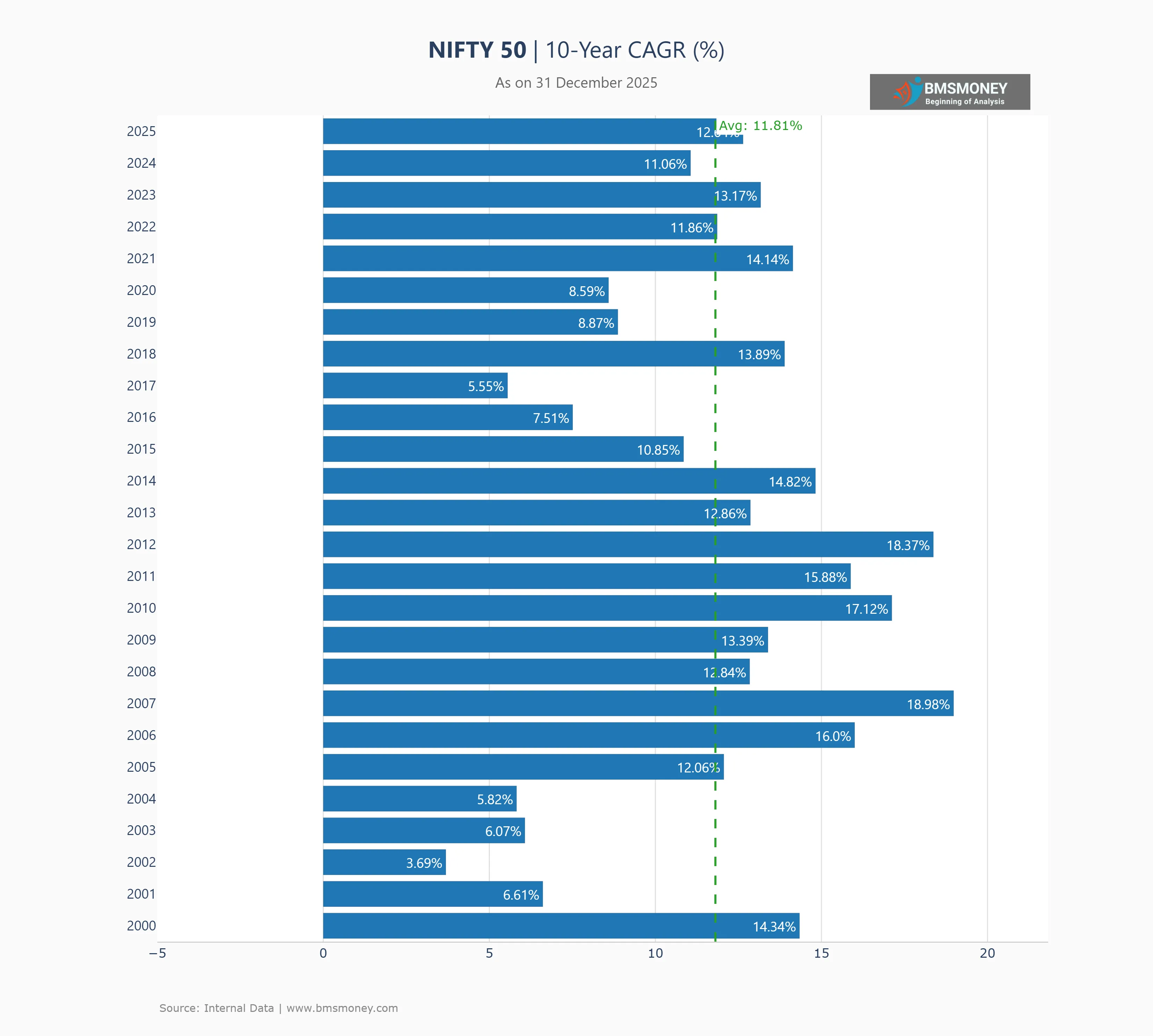
4.0 Long-Term Horizon Analysis: The Power of Compounding and Stability (15- to 30-Year Periods)
Examining investment horizons of 15 years or more reveals the true power of compounding and the underlying long-term growth trend of the market. Over these extended durations, the noise of short- and medium-term economic cycles is filtered out, exposing a pattern of remarkable consistency and stability in returns. The table below summarizes the key performance metrics for these long-term periods.
|
Investment Horizon |
Average CAGR (%) |
Maximum CAGR (%) |
Minimum CAGR (%) |
|---|---|---|---|
|
15 Years |
12.29% |
16.30% |
7.20% |
|
20 Years |
12.34% |
15.72% |
9.42% |
|
25 Years |
11.81% |
13.66% |
9.77% |
|
30 Years |
11.59% |
13.29% |
10.50% |
An evaluation of this data highlights a tight clustering of the 'Minimum' and 'Maximum' CAGR figures, particularly as the horizon extends beyond 20 years. This convergence demonstrates an exceptionally high degree of return predictability. Furthermore, the average CAGRs across all these long-term horizons are remarkably consistent, falling within a narrow band of 11.59% to 12.34%. The critical insight is that over these durations, long-term investors in the NIFTY 50 have historically been compensated with equity-like returns that approach the consistency of a fixed-income instrument.




5.0 Synthesis and Key Investment Principles
This analysis has journeyed from the high-stakes volatility of short-term market timing to the predictable and rewarding landscape of long-term investing. The historical data of the NIFTY 50 provides a clear and compelling narrative about the relationship between time, risk, and return. The core findings from this report can be distilled into three fundamental investment principles.
1. The Inverse Relationship Between Time and Volatility: As the investment duration increases, the range of potential return outcomes narrows dramatically. The extreme highs and lows seen in one-year periods progressively smooth out, systematically reducing investment risk and enhancing the predictability of returns.
2. The Horizon for Capital Preservation: Based on this historical data, a holding period of 10 years or more has been sufficient to eliminate the risk of negative annualized returns in the NIFTY 50. This marks a critical threshold where the focus shifts from risk of loss to the range of positive growth.
3. The Consistency of Long-Term Compounding: Disciplined investors with a horizon of 15 years or more have historically been rewarded with a consistent average Compound Annual Growth Rate within a remarkably narrow band of 11.5% to 12.4%. This underscores the powerful benefit of maintaining long-term exposure to the index, allowing the engine of compounding to drive substantial wealth creation.
4 Surprising Truths a 30-Year NIFTY 50 History Can Teach Us About Investing
The Rollercoaster vs. The Highway
For many people, the stock market feels like a terrifying rollercoaster. The sharp drops and sudden climbs can trigger anxiety, making it tempting to jump off at the first sign of trouble. This fear of volatility is understandable, but it's often based on a short-term perspective that magnifies the bumps and obscures the bigger picture.
We're going to dismantle that fear by analyzing three decades of NIFTY 50 index returns. The data reveals a series of surprising truths that transform market risk from a gamble into a predictable, long-term highway to wealth creation.
1. Short-Term Returns Are a Casino. Long-Term Returns Are Not.
Looking at the market's performance over a single year is a recipe for emotional decision-making. One-year returns are wildly unpredictable and swing between extreme highs and devastating lows. It’s less like investing and more like a spin of the roulette wheel.
To see this in action, just look at the NIFTY 50's annual returns. In 2009, an investor would have celebrated an astonishing gain of +75.76%. However, an investor who started just one year earlier would have been hit with a catastrophic loss of -51.79% in 2008. This casino-like environment is precisely what drives emotionally-fueled decisions—buying high in a year like 2009 out of FOMO, and selling low in a year like 2008 out of panic. The data shows this is a losing game.
2. Over 10 Years, Patience Has Never Failed
Here is a powerful and counter-intuitive fact revealed by the data: the probability of losing money in the NIFTY 50 has historically plummeted the longer you stay invested. While short-term results are a coin toss, the long-term picture is one of remarkable consistency.
Based on rolling 10-year periods ending between the year 2000 and 2025, there has been zero negative rolling 10-year periods. Let that sink in: for any ten-year stretch in the last quarter-century, the NIFTY 50 has never lost money. This fact doesn't just reframe risk; it obliterates the short-term definition of it. Even the absolute worst 10-year period for an investor in this dataset—the one ending in 2002—still produced a positive Compound Annual Growth Rate (CAGR) of 3.69%. The primary risk, therefore, isn't market failure; it's a failure of patience.
3. Your "Worst Case" Gets Surprisingly Better Over Time
The good news isn't just that the chance of loss vanishes over time. It's that your 'worst-case scenario' gets progressively better the longer you stay invested. In other words, the longer you commit, the higher the floor for your lowest possible return has historically been.
Consider the lowest CAGR an investor would have experienced over different holding periods, according to the data:
• Lowest 5-Year CAGR: -3.24% (for the period ending in 1998)
• Lowest 10-Year CAGR: +3.69% (for the period ending in 2002)
• Lowest 15-Year CAGR: +7.2% (for the period ending in 2008)
• Lowest 20-Year CAGR: +9.42% (for the period ending in 2013)
This trend is incredibly reassuring. Time has acted as a powerful safety net, systematically improving the outcome for even the "unluckiest" investors. A longer holding period has historically turned potentially poor entry points into respectable, and often excellent, long-term gains.
4. The Longer the Journey, the More Predictable the Destination
Perhaps the most important lesson from the data is how dramatically predictability improves over time. As the investment horizon lengthens, the range between the best and worst possible outcomes narrows significantly. This convergence toward a predictable average is the mathematical engine of long-term wealth. It's what makes goals like retirement planning not just possible, but statistically probable for the disciplined investor.
Let's contrast the short-term with the long-term. The 1-year returns show a massive performance gap of over 127 percentage points, swinging from a low of -51.79% to a high of +75.76%. This is pure chaos. Now, compare that to the 20-year returns. The range of outcomes for any 20-year holding period in the dataset is incredibly tight—a spread of only about 6.3 percentage points (from a low CAGR of 9.42% to a high of 15.72%). This narrowing range proves that long-term success is far less about "getting lucky" with market timing and far more about the simple discipline of staying invested for the journey.
Conclusion: What's Your Time Horizon?
The 30-year history of the NIFTY 50 tells one undeniable story: time is the ultimate arbiter of investment success. It smooths out terrifying volatility, mitigates the risk of loss, and turns the unpredictable chaos of the daily market into a remarkably consistent wealth-creation engine. The key is shifting your focus from the immediate noise to the long-term signal.
Knowing that history rewards a ten-year view, how might that change the way you think about today's market headlines?